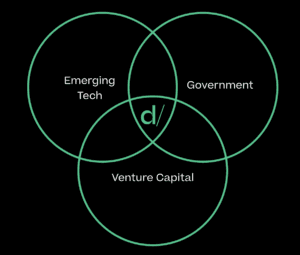Jun 25, 2025
Linking Government, Tech, and Venture to Effectively Accelerate Innovation

The Tech Adoption Ecosystem in the Federal Government
Today, the federal government has no shortage of need to accelerate innovation across its organizations. Federal agencies overall look to improve service delivery to the public while increasing efficiency and cost effectiveness. Defense organizations seek to accelerate deployment of critical technology to meet mission needs both on and off the battlefield. These requirements now face further urgency on the heels of new executive orders requiring federal agencies–and the Department of Defense (DoD) in particular– to modernize acquisitions and adopt a commercial-first approach to technology adoption. The need to improve U.S. technological advantage means that federal agency leaders must understand the interconnected nature of the tech adoption ecosystem—government, tech firms, and venture capital—and make meaningful shifts to work with the tech industry and venture firms effectively.
The Ecosystem—and the Stakes
Closing the gap between innovation and government depends on each part of the ecosystem showing up strong and understanding the others. Government is a potential large market for the tech industry and a buyer of tech solutions with the potential to bolster cutting-edge companies, increase competition, and benefit from the resulting innovation. Venture capital firms also increasingly are looking to fund tech companies entering the federal market given the promise of long-term revenue to increase the value of their portfolio companies. Yet for all the promise of these interconnections, Dcoders have seen roadblocks and bureaucracy stand in the way of their potential. “Government isn’t getting the tech it needs right now because the moat between innovation and federal adoption is simply too big,” says Tait Ryssdal, Federal Accelerator Lead at Dcode. “So it’s incumbent on government to shrink that moat so that more companies can enter the federal market and deliver impactful technology. This is where the best tech is being made, and it’s what the government needs to move the needle.” Dcode Capital Managing Partner Rebecca Gevalt adds that failure to strengthen the tech adoption ecosystem may lead to a self-reinforcing cycle of technological decline, making it increasingly difficult for government to attract, implement, and benefit from leading technologies and tech talent. “If innovative tech companies can’t gain a foothold in government, venture firms lose interest in funding those projects, and federal programs lose out on the best tech,” she says. “And at some point, you then have far less talent willing to work in government with huge implications for decline of critical services and national security concerns.”
Aligning Risk Tolerance to Move the Needle
Avoiding this scenario requires a recognition of the misaligned acquisitions risk tolerance between government, tech, and venture. “Tech companies are looking for big swings—they are bred to take risks and seek rapid growth, which is completely opposite government which is historically very risk averse,” says Ryssdal. The result has led to long procurement processes, high security compliance barriers, and complex contract requirements that favor incumbent prime contractors and create considerable barriers to entry for innovative companies.
A Better Government Buyer Makes a Stronger Federal Tech Ecosystem
Momentum is building to address these challenges, as the current and recent administrations have made moves to accelerate federal acquisition timelines and prioritize commercial technology. The key is how government wields its purchasing power. “Success now depends on government being a better buyer,” says Gevalt. “When federal agencies are better buyers, the entire ecosystem unlocks. The tech industry will want to build what government needs and sell it to them, venture firms will tell their portfolio companies to sell to government, talent will want to work on the tech that serves their missions.” To do it, Dcoders emphasize that government must understand a key market reality: while federal agencies increasingly depend on industry, the reverse is less often the case. Highly innovative companies will find a foothold in other markets. For government to leverage their cutting-edge technologies, it must become more adaptable, transparent, and understanding of the industry’s needs by:
Reducing bureaucratic barriers with more agile, flexible, and industry-responsive contracting practices that avoid vendor lock-in, shorten sales timelines, and increase competition
Creating flexible federal market entry points such as offering non-dilutive funding with Small Business Innovation Research (SBIR) and Small Business Technology Transfer (STTR) programs as well as Other Transaction Authority (OTA) contracting mechanisms; creating pathways for incremental growth for small tech companies; and reducing compliance barriers where appropriate
Recognizing mutual benefits with common goals toward enabling adoption of high-value technologies that achieve mission outcomes
Enabling predictable, achievable revenue streams with acquisition processes that demonstrate government to be a sustainable customer for a broader range of the tech industry
Responsibilities for Tech and Venture
While government takes on the lift of being a better buyer, the tech industry and venture firms that fund them have shifts to make as well in order to strengthen the ecosystem. “Tech companies must be proactive, strategic, and willing to invest time and resources in understanding the unique government market landscape and ensuring their technologies meet mission needs,” notes Ryssdal. From ensuring robust R&D and tech de-risking processes to identifying government opportunities, leveraging small business programs, and setting proper success expectations, the steps to federal market entry can be approached strategically to meet both company needs and government expectations.
Learn More Learn more about how Dcode is helping achieve a tech-enabled government: https://dcode.co/tech-enabled-government/ Discover how the Dcode Federal Accelerator is preparing tech companies to enter the federal market: https://dcode.co/federal-accelerator/ Explore how Dcode Capital is linking venture firms and tech companies to improve government: https://dcodecapital.com/


